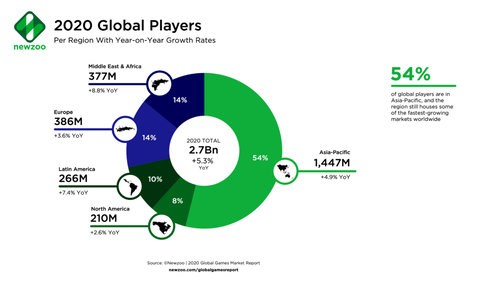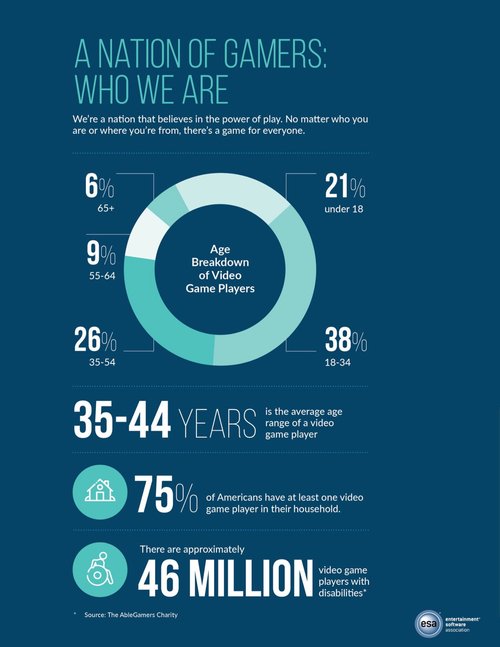Exciting Projects at the Intersection of Video Games, Computer Science and Education
When you hear or read the words “video games”, what’s the first thing that comes to mind? Childhood memories? Waste of time? Fun free-time activity? Something only kids use?
Personally, I have drawn some of these connections in the past (fun free-time activity), and some of them are still in place (childhood memories). However, nowadays, I mostly see video games as some of the most used and most promising media — something that has the potential to benefit old and young alike. Why? Let’s start with some numbers.
The Stats
Two well known sources within the realm of video game market analytics are Newzoo (global analytics) and the ESA (American Entertainment Software Association). According to the former’s 2020 global report, there were 2.55 billion video game players in 2019, and we will be reaching an estimated 2.69 billion by the end of this year. That’s about 34% of the world’s population! In terms of regional distribution, half of this number is located in Asia-Pacific, which isn’t very surprising:

However, one other thing that came as a surprise to me was the vast majority (93) of those 2.69 billion being mobile game players. Next in order are 1.3 billion PC players and lastly 800 million console players, while there are of course many people who fall into multiple or even all of the categories. However, depending on how the categorization took place, these numbers might not be as telling as they seem— it is imaginable that having once played (or even just downloaded) a mobile game is sufficient to count as a “mobile game player”, which would skew the actual distribution of players.
According to the ESA’s 2020 report, there are 214.4 million active video game players in North America (so a tiny bit of discrepancy from Newzoo’s numbers), with only 21% of them being under 18, thus it’s definitely not the case that only kids play video games. However, most kids (under 18) in North America, 70% of them to be exact, are active players. There’s also an approximate 13 million of video gamers older than 65!

The most popular video game genres in North America, when looking at the largest demographic (age group 18–54), are shooter games (e.g. CoD) and casual games (e.g. Tetris) for men, as well as family games (e.g. Mario Kart) and arcade games (e.g. PacMan) for women. On a related note, and possibly contrary to expectation, 41% of video game players in North America are women!
State of the Art in Research
Most of the psychological research, which was largely conducted in the past 20 years, has been focused on action video games and their impact on players in terms of perception, cognition and attention.
Broadly speaking, one can differentiate between two types of studies within the field:
a) Cross-sectional studies that compare the perceptual, attentional and cognitive skills of action video game players with those of non-action video game players (also non-video game players)
b) Intervention studies that aim to train non-video game players’ perceptual, attentional and cognitive skills by the use of action video games to research causal effects
A recent meta-analysis from Bediou et al. (2018) evaluated many cross-sectional as well as intervention studies between 2000 and 2015. One thing to keep in mind is that the samples of the included studies almost exclusively consisted of young males. Here’s their conclusion:
Overall, the present meta-analysis confirms a medium size impact of habitual action video game play on cognition and a small-to-medium size effect of training young adults with action video games on a few cognitive domains [e.g. spatial cognition and top-down attention].
On the other hand, critical voices such as the one from Sala and Gobet (2019) — while acknowledging a minimal effect of action video game play on cognitive abilities — argue that the benefits are not transferable to “general cognitive ability” (i.e. to domain-general abilities that are relevant outside of video games). They also mention methodological concerns (e.g. how video game skill is measured), publication bias and inconsistency of reported results (some significant, others not) as reasons for the discrepancy between the medium effect observed by others and the minimal effect observed by them.
Furthermore, recent discussions (e.g. Dale et al. 2020) question the usefulness of current categorization methods for video games moving forward, as newly emerging, multi-genre games (such as MOBA games like League of Legends) suggest similar benefits to those of action video games (e.g., Large et al., 2019). It has been proposed that a focus on the specific mechanics and components of games might be more expedient in regards to categorizing them.
But what does this have to do with Education and Computer Science?
Why might games be relevant when it comes to education and computer science? The Future Learning Initative of ETH Zurich is a beautiful example of this. Here’s a quote from their website:
FLI [Future Learning Initative] brings together 23 professors across 9 departments with the goal of synergizing existing expertise, while simultaneously accelerating impact through coordinated inter-departmental and inter-disciplinary collaboration. Our goal is to transform the higher education system by: Understanding the nature of formal and informal learning as a complex phenomenon across multiple, interacting levels: neural, cognitive, embodied, social, and cultural; Translating research into practice, first at ETH Zurich and then at the gymnasium, by designing cutting-edge applications in domain-specific learning, learning environments & technologies, and learning & data sciences
One concrete example of this would be FLI’s Embodied Learning and Gaming project utilizing Augmented Reality (AR) with the aim of enhancing learning and teaching. Here’s a corresponding quote from the project’s “Research Goals” section:
… Augmented reality games have the unique capacity to allow novices to experience intellectually productive problems central to science in a psychologically safe place where they can experiment with new ideas and identities and learn through failure [Koutromanos, 2015]. In this project, we will explore how and why an augmented reality learning environment can improve learning and transfer of abstract mathematics concepts. We will focus mainly on Higher Education and mobile-based see-through AR.

In short, the project uses expertise in Computer Science to build the AR-(game-)components while combining this with knowledge drawn from Educational Sciences in order to create new, future-oriented ways of teaching and learning!
There’s many more projects that the FLI encompasses — if you would like to read more about them, you should go have a look at their website. ETH’s Game Technology Center is also worth checking out for more.
That’s all for now — thanks for reading and see you next time!